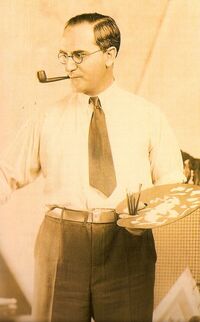
Ferdinand Hovarth, c. 1930.
Ferdinand Hovarth (full name Ferdinand Huszti Hovarth, 1881-1973) was a successful New York-based illustrator and an inspirational sketch artist at the Disney studio from 1933 to 1937. He created art for many animated shorts, but is perhaps best remembered for his uncredited work for Snow White and the Seven Dwarfs.
Early life and Education (1881-1903)
Hovarth was born on August 28, 1881, in Budapest. His birth name was Nandor Mahaly Lowenstein; in 1902 his father, Nandor, changed the Jewish family name from Lowenstein to Hovarth, and converted to Roman Catholicism. Nandor was eager that his son follow in his footsteps, as a merchant of liquor and baked goods. At the time, however, Hovarth wanted to be an engineer, and registered at a preparatory school for engineers. Hovarth's decision to study art in Paris caused further conflict between his father and himself.
Life in the army and World War I (1904-1918)
In 1904 Hovarth enlisted as a reserve officer of the Austro-Hungarian army. Perhaps to distance himelf from his father he added "Huszti" to his last name, and changed his first name to "Ferdinand" (a German translation of Nandor). He became a First Lieutenant, but was wounded and captured, spending two and a half years in various prison camps. Here, Hovarth passed the time sculpting and drawing. At this point he began work on illustrations for Edgar Allen Poe's The Raven (these illustrations were published nearly fifteen years later).
After a deal with a Czarist sympathiser, Hovarth succeeded in escaping by horse and sleigh, thirty months after his capture. Hovarth escaped to Petrograd, where he was forced to disguise as a Russian peasant in order to move about safely. He eventually reached Finland and, with the intention of reaching the Swedish border, took a train, from which he jumped to the frozen water below, while being fired at, though he sustained no wounds from the shots. He reached the Swedish border and was given a ticket to Berlin. When he rcame to Budapest, he returned to the army, and fought until the end of the war.
Marriage and move to New York (1920-1928)
Hovarth fell in love with Rafaella Francisca Elizabeth Koellesz (Elly for short), a ballet dancer descended from nobility. Their relationship caused Elly to cancel her planned engagement and marry the Jewish son of a merchant in 1920, outraging her parents, who disowned her. Hovarth's father disapproved of a daughter-in-law with no dowry, and disinherited his son.
Hovarth first tried to make money by selling his paintings and drawings in Hungary, but then decided to move to America. He arrived in New York in 1921, on his own, sending for Elly when he earned enough money to ensure her passage. The couple became American citizens in 1927. Here, Hovarth did various odd jobs, painting window frames, barges and then dolls' heads, until he joined the studio producing Aesop's Film Fables. After Hovarth left the studio, he began work as a successful illustrator, and in autumn of 1928 his work was first exhibited at the Waldorf-Astoria Hotel, receiving considerable (favourable) attention from the press.
Disney (1933-1937)
On January 7, 1933, Hovarth began a six-month trial period of working at the Disney studio, but would end up working there for nearly four years. Unknown to Disney, Hovarth solicited a job at Warner Brothers animation studio during his trial period, as a safety measure during the Depression. Hovarth mentioned, in the many letters to his wife from the studio, that the studio was a "crazy house", where space was limited and everyone was constantly changing places.
Hovarth's first job at Disney was to design advertisng and promotional pieces. He also worked on backgrounds for The Cookie Carnival and The Band Concert and layouts for many other shorts, including Old King Cole. Other jobs include constructing a model of a windmill for The Old Mill and writing a critique on the use of surprise in effective gags. However, eventually, Hovarth was mostly used as an inspiratinal sketch artist. Like his colleague Albert Hurter, Hovarth produced many drawings, sometimes with humorous or grim subjects, as inspiration for Walt Disney's animators. However, unlike Hurter's designs, Hovarth's required reworking for conversion into the "Disney Style". As a result, fewer of his ideas were used.
Though his work was often appreciated, Hovarth was rather isolated from most of the crew at the studio. He was also gently teased, because of his Hungarian accent and middle name; this and his strange, quiet nature made him seem like some sort of Dracula character to his colleagues. William Cottrell did many caricatures of Hovarth, and worked with Albert Hurter on ideas for an unproduced short titled Hootsie the Owl.
Hovarth's departure from the studio in October 1937 may have been the result of his lack of onscreen credit for Snow White or any of the shorts, as well as his isolation within the studio.
Later work and "The Little Worksop" (1938-1973)
Between 1938 and 1939 Hovarth worked for Columbia, designing models and layouts for Screen Gems shorts; later, in 1940, he sculpted puppets for Paramount's Puppetoons, also making and selling porcelain figures. During World War II, Hovarth worked on confidential designs for North American Aviation, then Howard Hughes. After the war, he made various toys and birdhouses out of wood, selling them by mail order, calling their business "The Little Workshop". He and his wife moved to stay with her brother in Westminster West in Vermont, and continued their mail-order business. They eventually returned to California, where they moved to a very small house near Palm Springs. Hovarth died of a stroke on November 11, 1973.
References
- John Canemaker, "Before the Animation Begins: The Life and Times of Disney inspirational Sketch Artists"
